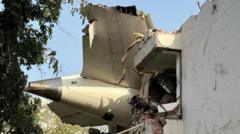After the devastating crash of Air India's Boeing 787-8 Dreamliner, the airline reports one engine was new while the other had a "clean" history. Investigators are now focused on flight data to uncover the incident's cause, amid safety checks and operational cutbacks.
**Air India Investigates AI171 Crash as Engine Conditions Are Scrutinized**

**Air India Investigates AI171 Crash as Engine Conditions Are Scrutinized**
**Air India clarifies the condition of aircraft engines involved in the tragic AI171 crash, emphasizing a thorough investigation is underway.**
An Air India Boeing 787-8 Dreamliner tragically crashed just after takeoff from Ahmedabad, leading to the death of at least 270 people. Following the accident, the airline's chairman, N Chandrasekaran, confirmed significant details regarding the engines used in the ill-fated flight AI171. Describing the right engine as new—installed in March 2025—and the left engine as serviced in 2023 with maintenance not due until December 2025, he asserted that both engines maintained a "clean" operational history.
In an exclusive interview with Times Now, Chandrasekaran cautioned against speculative theories and stated that experts will soon glean crucial information from the aircraft's black boxes, which are currently under examination. “We have to wait for the full details to surface from the recorded data,” he noted.
Kishore Chinta, previously an investigator with India's Aircraft Accident Investigation Bureau, explained that an engine's age doesn't necessarily indicate its reliability. The advanced Genx-1B engines in the Boeing 787-8 incorporate the Full Authority Digital Engine Control (FADEC) system, which continually assesses engine health and informs necessary service or replacement procedures based on generated data.
Nonetheless, Chinta mentioned that specific components, referred to as Life Limited Parts (LLPs), still have a defined lifecycle, usually requiring checks after 15,000 to 20,000 takeoff cycles, emphasizing the importance of comprehensive inspections.
In response to this catastrophe, Air India announced it will implement a 15% cut in international operations utilizing wide-body aircraft until mid-July, attributing this decision to "compounding circumstances" such as increased safety measures and elevated alertness among crew and ground personnel. This move comes alongside India's civil aviation regulator mandating extensive inspections of Air India’s Boeing 787 fleet.
Chandrasekaran communicated his organization's dedication to passenger safety, confirming that inspections on 26 of the 33 Dreamliner aircraft have already been concluded, with all cleared for service. The remaining aircraft are scheduled for checks in the coming days, and the airline's Boeing 777 fleet will also undergo enhanced safety audits.
The tragic crash poses significant challenges for Air India as it navigates the delicate transformation from a government-run to a privately owned entity under Tata Sons. With high-profile ownership since 2022, the conglomerate faces a critical test as it strives to revive the legacy of India’s former national carrier amid ongoing operational and reputational hurdles.






















